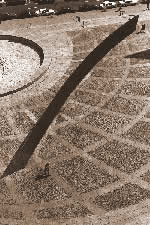


People react to works of art in their environment. Thoughtful consideration of how best to involve those who will engage the work is necessary to insure that the intended meaning is shared, supported, constructed and understood by a community.The links below provide information on a project by sculptor, Richard Serra, and, in contrast, Maya Lin's "Vietnam Veteran's Memorial." Serra's work "Tilted Arc," (1981) generated considerable controversy at the time. It was eventually destroyed, but the project is instructive on several levels when considering commissioning a public art project.
>
http://www.pbs.org/wgbh/cultureshock/flashpoints/visualarts/tiltedarc_a.html
This website provides a short introduction to the controversy surrounding
"Tilted Arc" and a subsequent link to the "Vietnam Veteran's
Memorial."
>
http://www.wilsoncenter.org/index.cfm?fuseaction=dialogue.program&dialogue_id=35694#
Casey Blake, an associate professor of history and director of the American
Studies Program at Indiana University, offers an interesting overview
of the evolution of public art in this interview. It is well worth the
read, and the conclusions are critical for public art projects undertaken
today.
>
http://www.geocities.com/SoHo/Square/1371/serra.html
A short essay exploring the "Tilted Arc" controversy.
>
http://www.pbs.org/wgbh/cultureshock/flashpoints/visualarts/thewall_a.html
Maya Lin's "Vietnam Veteran's Memorial" has experienced its
share of controversy, but the vast majority of response has been very
positive. Effective public arts projects provoke comment and community.
>
http://www.beloit.edu/~wright/pubart.htm
Contemporary public artists such as Siah Armajani have consciously considered
the meaning of 'public' and 'social' in their art works. Increasingly,
the need to understand and embrace the role of the artist-as-citizen and
contributor to constructing the social environment is becoming more prominent
in the public arts movement.
 |